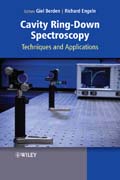
This book aims to provide a complete overview of CRDS, with introductory chapters on the fundamentals and general experimental schemes, and specialist chapters on applications and new developments in spectroscopic analysis,atmospheric chemistry, medical diagnostics, and combustion and plasma studies. Designed as both a starting point and a reference source, the bookis suitable for readers who are unfamiliar with the technique as well as experienced users.The only leading texts on this topic currently in print are outdated and there is an identifiable need for an updated discussion of the field Giel Berden is a senior scientist at the FOM Institute for Plasma Physics in the Netherlands. Richard Engeln is an Associate Professor in the Departmentof Applied Physics at Eindhoven Technical University. INDICE: PrefaceList of contributorsGlossaryChapter 1 - An introduction to cavity ring-down spectroscopy1.1 Introduction1.2 Direct absorption spectroscopy1.3 Basic cavity ring down spectroscopy setup1.4 A more refined picture1.5 Fitting of cavity ring down transients1.6 A few examples1.7 Going beyond the standard pulsed CRDS experiment1.8 Summary1.9 ReferencesChapter 2 - Cavity enhanced techniques using continuous wave lasers2.1 Introduction2.1 Properties of optical cavities and cw lasers relevant to cavity enhanced spectroscopy2.3 Experimental methods for cw laser cavity enhanced spectroscopy2.4 Spectroscopy with resonant cavities2.5 SummaryChapter 3 - Broadband cavity ring-down spectroscopy3.1 Introduction.3.2 The time and wavelength evolution of a single ringdown event.3.3 Two dimensional techniques: resolving broadband cavity output in time andwavelength.3.4 One dimensional techniques: time or wavelength.3.5 How to extract quantitative information from broadband spectra.3.6 Optimising the sensitivity of a broadband measurement.3.7 Applications of broadband cavity methods.3.8 References.Chapter 4 - Cavity ring-down spectroscopy in analytical chemistry4.1 Introduction4.2 Condensed media CRDS4.3 Evanescent-wave CRDS4.4 Future trends and perspectivesChapter 5 - Cavity ring-down spectroscopy using waveguides5.1. Introduction5.2. The basic experiments5.3. Optics and Instrumentation5.4. Review of waveguide CRD literature5.5. Conclusion and outlook5.6. AcknowledgementsChapter 6 - Cavity ring down spectroscopy of molecular transients of astrophysical interest6.1. Introduction6.2. Experimental6.3. Astronomical considerations6.4. Results6.5. OutlookAcknowledgementsReferencesChapter 7 - Applications of cavity ring-down spectroscopy in atmospheric chemistry7.1. Brief overview7.2. Measurement of trace atmospheric species by CRDS7.3. Laboratory based studies of atmospheric interest7.4. Optical properties of atmospheric aerosol particles7.5. Future developmentsChapter 8 - Cavity ring-down spectroscopy for medical applications8.1. Introduction8.2. Trace gases in medicine and biology8.3. Instrumentation for laser analytics of breath and other biological gas samples8.4. Applications to life sciences8.5. Conclusion and Perspectives8.6. ReferencesChapter 9: Studies into the growth mechanism of a-Si:H using in situ cavity ring-down techniques9.1. Introduction9.2. Gas phase CRDS on SiHx radicals9.3. Thin film CRDS on dangling bonds in a-Si:H films (ex situ)9.4. Evanescent wave CRDS on dangling bonds during a-Si:H film growthChapter 10 – Cavity ring down spectroscopy for combustion studies10.1. Introduction10.2. General description of cavity ring down spectroscopy in flames10.3. Experimental set-up10.4. Quantitative concentration measurements in flames10.5. Concentration profile determination10.6. Specific difficulties in combustion studies10.7. Case of particles: soot volume fraction determination10.8. Conclusion and prospectiveReferencesAppendix A Literature
- ISBN: 978-1-4051-7688-0
- Editorial: John Wiley & Sons
- Encuadernacion: Cartoné
- Páginas: 344
- Fecha Publicación: 01/11/2009
- Nº Volúmenes: 1
- Idioma: Inglés
